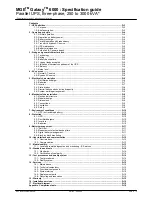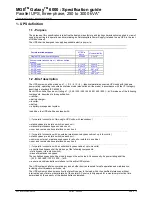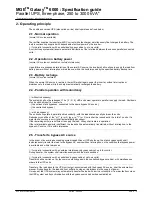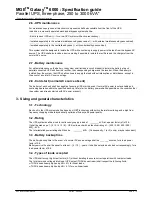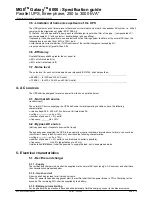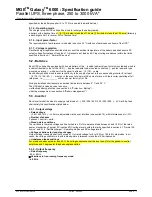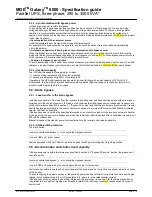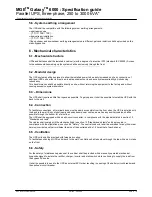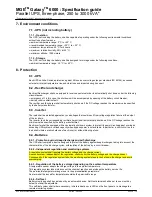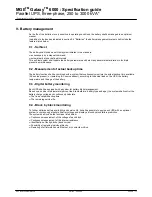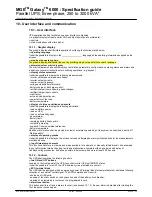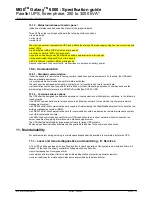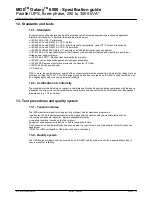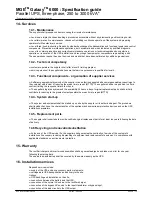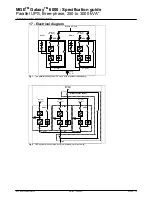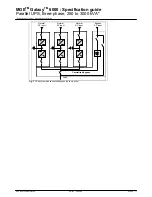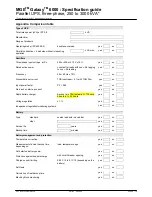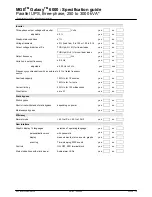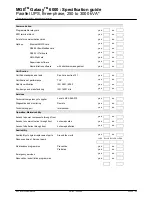
MGE
TM
Galaxy
TM
6000 : Specification guide
Parallel UPS, three-phase, 250 to 3000 kVA*
* Power rating for an N+1 redundant configuration
APC By Schneider Electric
Edition - 03/2009
Spec. E - 10
7 - Environment conditions
7.1 - UPS (not including battery)
7.1.1 - Operation
The UPS, not including the battery, shall be capable of operating under the following environmental conditions
without loss of performance:
ω
ambient temperature range: 0° C to +40° C.
ω
recommended temperature range: +20° C to + 25° C;
ω
maximum temperatures: 40 °C for 8 hours
ω
maximum relative humidity: 95% at 25° C;
ω
maximum altitude: 1000 meters.
7.1.2 - Storage
The UPS, not including the battery, shall be designed for storage under the following conditions:
ω
ambient temperature range: -10° C to +45° C.
8 - Protection
8.1 - UPS
Each UPS unit shall include protection against AC-source overvoltages (as per standard IEC 60146), excessive
external or internal temperature rise and vibrations and impacts during transport.
8.2 - Rectifier and charger
Each rectifier/charger shall be equipped to receive an external order to automatically shut down under the following
circumstances:
ω
emergency off; in this case, the shutdown will be accompanied by opening of the battery circuit breaker;
ω
battery room ventilation fault.
The rectifier and the charger shall automatically shut down if the DC voltage reaches the maximum value specified
by the battery manufacturer.
8.3 - Inverter
The load shall be protected against any overvoltages that could result from voltage regulation failure at the output
of the inverters.
The inverter (and the corresponding rectifier/charger) shall automatically shut down if the DC voltage reaches the
minimum value specified by the battery manufacturer.
Each inverter shall be equipped with an automatic shutdown system to protect its power circuits against overloads
exceeding UPS-system overload capacity when bypass power is not available. In particular, a short-circuit on the
load shall initiate a static shutdown of each inverter, without blowing a fuse.
8.4 - Batteries
8.4.1 - Protection against deep discharge and self-discharge
The UPS shall comprise a device designed to protect the battery against deep discharges, taking into account the
characteristics of the discharge cycles, with isolation of the battery by a circuit breaker.
8.4.2 - Independent regulation and monitoring systems
A regulation system shall regulate the battery voltage and the charge current.
A second system, independent of the regulation, shall monitor the battery voltage and the charge current.
Consequently, if the regulation system fails, the monitoring system steps in to shut down the charger and avoid
overcharging.
8.4.3 - Regulation of the battery voltage depending on the ambient temperature
A temperature sensor adapts the charge voltage to the ambient temperature.
This regulation system takes into account the chemical reaction and prolongs the battery service life.
The permissible temperature range is set in the personalisation parameters.
An alarm shall be issued for temperatures outside the permissible range.
8.4.4 - Self-test
Battery monitoring shall be carried out by an automatic device. Self-test intervals shall be set to one month by
default, but shall be adjustable.
This self-test system shall, where necessary, initiate indications via LEDs on the front panel or a message to a
remote monitoring system.


